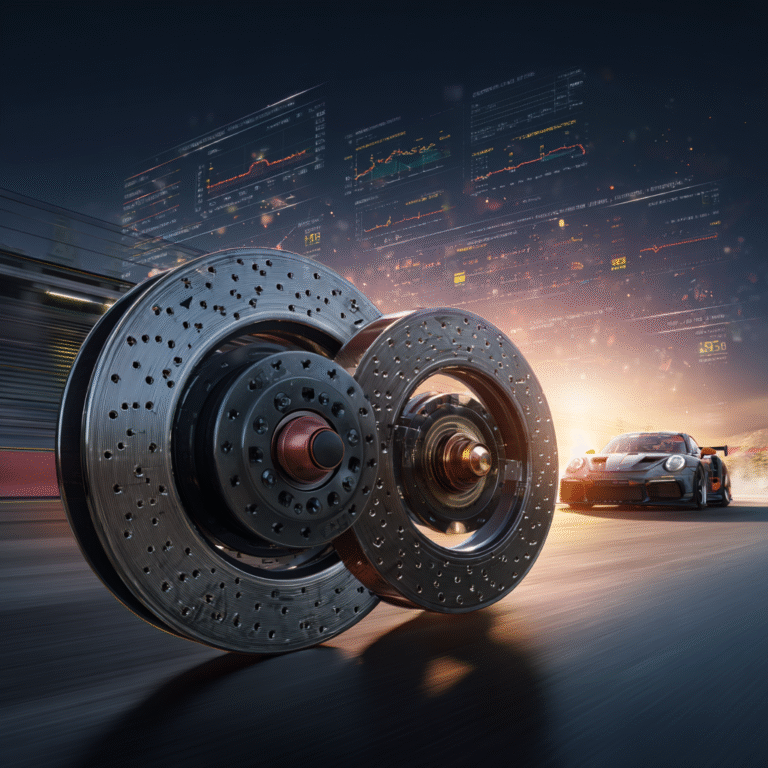TL;DR:
-
Carbon-Ceramic Brakes: Advanced brake technology offering superior performance through unique composite materials designed for high heat resistance.
-
Functionality and Benefits: These brakes operate effectively in extreme conditions, providing exceptional heat dissipation, lightweight handling, and increased performance, though at a higher initial cost.
-
Drawbacks: Higher replacement costs and possible fragility compared to traditional materials are key concerns.
-
Steel Brakes: A conventional option known for its reliability and cost-effectiveness, functioning well under routine conditions but not excelling in extreme performance scenarios.
-
Advantages and Limitations: Steel brakes are durable and affordable, but they can suffer from weight issues and heat retention, impacting performance during prolonged use.
-
Performance Comparison: Carbon-ceramic brakes outperform steel in heat dissipation and weight, but steel brakes excel in maintenance and initial affordability.
-
Cost Analysis: Initial investments in carbon-ceramic systems are higher, but they may lead to lower long-term maintenance costs; steel brakes have lower upfront costs but higher replacement frequency.
-
Future Trends: Technological advancements are expected to shape brake design significantly, with predictions suggesting carbon-ceramic systems may dominate by 2025, appealing to performance-oriented consumers.
Introduction
When it comes to braking performance, the debate of carbon-ceramic brakes vs steel: what wins is more relevant than ever as we approach 2025. As cars evolve, so do their components, and brakes are no exception. Carbon-ceramic brakes promise less weight, superior heat management, and a longer lifespan. On the other hand, steel brakes offer reliability and affordability. Each has its devoted supporters and unique advantages. In this article, we’ll dive into the strengths and weaknesses of both braking systems. We’ll explore how advancements in technology and design will shape the future of braking systems. Buckle up; it’s going to be an insightful ride!
What Are Carbon-Ceramic Brakes?
If you’re a car enthusiast or simply someone who appreciates cutting-edge automotive technology, you may have heard of the buzz surrounding carbon-ceramic brakes. But what exactly are these high-performance components, and how do they stack up against more traditional braking systems like steel? As our vehicles become faster and more powerful, the need for advanced brake technology is paramount, making the comparison of carbon-ceramic brakes vs steel particularly relevant.
Carbon-ceramic brakes consist of a composite material made from carbon fiber and ceramic, which is baked at high temperatures to create a lightweight yet incredibly strong braking system. These brakes are often found in premium sports cars and racing vehicles, thanks to their superior performance characteristics. But how do they function, and what makes them different from their steel counterparts?
How Do Carbon-Ceramic Brakes Work?
The effectiveness of carbon-ceramic brakes is largely due to their unique construction. The combination of carbon fibers and ceramic molecules produces a brake disc that is exceptionally resistant to heat and wear. When you apply the brakes, the brake pads grip the high-friction surface of the disc, quickly converting kinetic energy into thermal energy, which dissipates seamlessly due to the material’s resistance to deformation and thermal expansion.
This efficient mechanism allows carbon-ceramic brakes to operate effectively at high temperatures, maintaining consistent braking performance even during rigorous driving conditions. The design not only enhances performance but also contributes to a vehicle’s overall weight reduction, improving handling and agility.
What Are the Key Benefits of Carbon-Ceramic Brakes?
The advantages of carbon-ceramic brakes are hard to ignore:
- Enhanced Performance: They offer superior stopping power and heat resistance, ideal for high-performance vehicles.
- Weight Reduction: Their lighter weight helps improve handling and fuel efficiency.
- Longevity: Carbon-ceramic brakes tend to outlast traditional steel brakes, reducing the frequency of replacements and related costs.
- Reduced Brake Fade: They maintain their performance under extreme conditions without experiencing the brake fade often seen with steel brakes.
These benefits make them a desirable option for car manufacturers and enthusiasts alike, leading many to consider carbon-ceramic brakes vs steel as a pivotal choice in performance upgrades.
Are There Any Drawbacks to Carbon-Ceramic Brakes?
However, carbon-ceramic brakes are not without their downsides.
What Are Steel Brakes?
Steel brakes are one of the most commonly used braking systems in the automotive industry. They offer a reliable and effective solution for decelerating vehicles across various types of automobiles, particularly in everyday driving scenarios. The discussion of carbon-ceramic brakes vs steel often hinges on performance, durability, and costs—this overview will clarify the role and characteristics of steel brakes, setting the stage for a deeper understanding of their advantages and limitations.
How Do Steel Brakes Function?
Steel brakes operate through the interaction of steel brake rotors and friction pads. When the brake pedal is pressed, hydraulic force pushes the pads against the rotors, creating friction that slows down or stops the vehicle. This system efficiently converts kinetic energy into thermal energy, effectively halting the vehicle. The robustness of steel makes it durable under most conditions, catering to a wide range of drivers.
What Are the Advantages of Steel Brakes?
Steel brakes present numerous advantages:
- Cost-Effective: Generally more affordable than alternative systems like carbon-ceramic brakes.
- Widespread Availability: Parts are readily available and manufacturers typically cater to a wider range of vehicles.
- Performance: They offer consistent performance in everyday driving conditions.
- Durability: Steel brakes are built to withstand wear and offer longevity, reducing the frequency of replacement.
These benefits make steel brakes a popular choice for daily drivers and budget-conscious consumers.
What Limitations Do Steel Brakes Have?
Despite their advantages, steel brakes come with limitations:
- Heat Dissipation: They can struggle with heat management during high-performance driving, leading to brake fade.
- Weight: Steel components are heavier, which can negatively impact the overall weight of the vehicle, affecting fuel efficiency and handling.
- Performance: They may not perform as well as carbon-ceramic brakes under extreme conditions, such as racing or heavy towing.
When comparing carbon-ceramic brakes vs steel brakes, it’s essential to weigh these factors to determine which system aligns best with your driving needs and style.
How Do Carbon-Ceramic and Steel Brakes Compare in Performance?
When it comes to performance, the right braking system can make all the difference in a vehicle’s handling and safety. Carbon-ceramic brakes vs steel: what wins in various performance metrics? Understanding how these two brake systems operate helps clarify their advantages and disadvantages in real-world driving scenarios.
Which Braking System Offers Better Heat Dissipation?
Heat dissipation is crucial for maintaining braking performance. Carbon-ceramic brakes outshine steel counterparts here, as they can endure and dissipate higher temperatures efficiently. This prevents brake fade during prolonged use, making them ideal for high-performance vehicles. Steel brakes, while generally effective, tend to overheat under extreme conditions, potentially affecting their reliability.
How Do They Differ in Weight and Handling?
Weight plays a significant role in vehicle dynamics, and carbon-ceramic brakes are typically lighter than steel. This reduced weight not only enhances acceleration but also contributes to improved handling and agility. Steel brakes, being heavier, can lead to increased unsprung mass, affecting ride quality and responsiveness, especially in performance-oriented vehicles.
What Impact Do They Have on Vehicle Maintenance?
Maintenance demands vary significantly between these two systems. Carbon-ceramic brakes require less frequent replacement due to their durability, translating to lower long-term costs and hassle for owners. Conversely, steel brakes often need more regular upkeep and can suffer from wear more quickly, leading to higher maintenance requirements over time.
For further information, you can explore more on Car and Driver, MotorTrend, Edmunds, AutoWeek, Roadshow, and Top Gear.
What Is the Cost Comparison Between Carbon-Ceramic Brakes and Steel Brakes?
When it comes to choosing between carbon-ceramic brakes vs steel, understanding the cost implications is crucial. While both have their merits, the initial outlay and long-term expenses can differ significantly, impacting buyers’ decisions.
How Does the Initial Investment Differ?
The initial investment in carbon-ceramic brakes is notably higher than that of steel brakes. Typically, carbon-ceramic systems can range from $5,000 to $12,000, depending on the vehicle model and brand. In contrast, steel brake systems generally cost between $300 and $1,500, making them an attractive option for budget-conscious consumers.
What Are the Long-term Cost Implications of Each?
In the long run, carbon-ceramic brakes can save owners money due to their durability and reduced maintenance requirements. These brakes often last longer and perform better under extreme conditions, leading to fewer replacements over time. Steel brakes, while cheaper initially, may require more frequent maintenance and replacements, leading to higher costs in the long term.
How Do Replacement Costs Vary?
Replacement costs for carbon-ceramic brakes can be substantial, often running into thousands of dollars due to the composite materials used. Steel brakes, on the other hand, are considerably less expensive to replace, typically costing a few hundred dollars. This difference plays a significant role for drivers considering long-term investments in their vehicles.
For more insights on braking systems, check out Car and Driver, MotorTrend, Edmunds, Jalopnik, AutoWeek, and CNET.
What Is the Future of Braking Systems?
As automotive technology continues to evolve at an unprecedented pace, one of the most crucial areas of development is braking systems. With advancements in materials, engineering, and integration with electronic systems, understanding the trajectory of braking technology is vital for consumers and manufacturers alike.
How Will Technological Advancements Influence Brake Design?
The future of brake design will heavily rely on innovations such as:
- Sophisticated Materials: Incorporating lightweight composites will enhance performance while reducing weight.
- Smart Technology: Integration of sensors and predictive algorithms will enable real-time assessments of brake system health.
- Regenerative Braking: This technology will continue to rise, especially in electric vehicles, capturing energy during braking and improving efficiency.
These advancements will enhance both safety and efficiency, shaping the vehicles of tomorrow.
What Trends Should We Expect in the Next Few Years?
Anticipated trends include:
- Hybrid Systems: Increased adoption of hybrid braking systems that combine traditional and emerging technologies.
- Sustainability: A focus on eco-friendly materials and manufacturing processes, aligning with global environmental goals.
- Customization: Expect a rise in customizable braking solutions tailored to specific driving styles and conditions.
These trends reflect the automotive industry’s commitment to innovation and sustainability.
Which Braking System Will Dominate by 2025?
By 2025, it’s likely that hybrid brakes, melding carbon-ceramic technology and traditional steel systems, will dominate. Factors like performance, cost, weight, and heat dissipation will shape consumer preferences. Furthermore, the push towards electric vehicles will accelerate the adoption of cutting-edge braking technologies that prioritize energy conservation and efficiency.
For more insights on future technologies in braking systems, explore resources from renowned automotive organizations like “Automotive News,” “Car and Driver,” and “Edmunds.”
Conclusion:
In the showdown of carbon-ceramic brakes vs steel: what wins, we’ve explored the strengths and weaknesses of each braking system. Carbon-ceramic brakes offer weight reduction and superior performance but at a higher cost, while steel brakes provide reliability and affordability for everyday use. Ultimately, the choice between these two technologies will depend on your specific driving needs and budget. As you contemplate which braking system is right for you, consider revisiting our resources to discover more insights on performance upgrades and automotive technology. Your next brake system could redefine your driving experience—don’t stop here!



